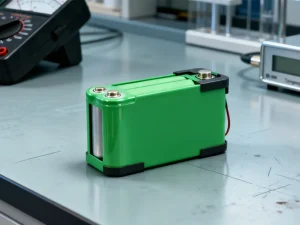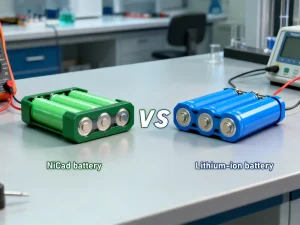NiCad batteries and lithium-ion batteries have different usage scenarios. NiCad batteries are specialized tools for specific professional applications. You might find an old remote control or toy that needs a new battery. Some of these older devices need NiCad batteries. By contrast, lithium-ion batteries mainly offer superior performance for everyday electronics. For example, mobile phones and laptops use lithium-ion batteries. Why does this difference happen? NiCad VS lithium-ion batteries is a meaningful comparison. But which is better? Here are some analyses of this comparison.
What is a NiCad Battery?
A NiCad battery is a DC rechargeable battery. It uses nickel hydroxide and metallic cadmium as the positive and negative active materials. It is an old-fashioned rechargeable battery. The NiCad battery was the first true “portable appliance revolution.”

Before the NiCad battery, power cords tethered many devices. With its advent, cordless phones, Walkmans, and handheld cameras became possible. These devices were now truly portable and usable. Because power cords no longer bound them. Besides, its high discharge capacity enabled the first generation of portable power tools. It promoted changes in working methods in industries such as construction and decoration. In the late 20th century, many advanced portable devices required rechargeable power. NiCad batteries powered nearly all of them.
The NiCad battery was rechargeable. It was also durable. Most importantly, it could deliver a powerful, instantaneous current. These combined advantages allowed it to usher in a new era for portable electronics.
Although it is durable and can discharge quickly, it has a significant memory effect. That is, if people do not discharge it completely, the capacity will decrease. But it contains the heavy metal cadmium, which pollutes the environment.
What is a Lithium-ion Battery?
A lithium-ion battery is a type of rechargeable battery. Its function depends on a key process: the movement of lithium ions. These ions move between the positive and negative electrodes. It is a modern high-performance rechargeable battery.

Lithium-ion batteries offer unparalleled energy density and a convenient user experience. Lithium-ion batteries have become one of the cornerstone technologies of modern society. They offer thin and light mobile devices with long battery life. Besides, lithium-ion batteries can support electric cars. A large battery pack sits at the heart of every electric vehicle, providing its primary power. This pack forms the foundation of the car. It combines thousands of small lithium-ion batteries working together. Lithium-ion batteries have revolutionized the way modern society uses energy.
But lithium-ion battery technology is expensive. Not only that, but this system needs complex protection circuits. They are essential to prevent dangers from overcharging or short circuits.
NiCad VS Lithium-ion Batteries
1. Energy Density
Energy density is essential in discussions on NiCad VS lithium batteries.
-
Lithium-ion batteries have a high energy density. This means that lithium-ion batteries can store more energy at the same volume or weight. High energy density is a key battery characteristic. For one thing, it actively drives development in several fields. For example, smartphones, ultra-thin laptops, and electric vehicles all benefit from it. For another thing, this technology significantly reduces device weight. It also enables them to have longer-lasting battery life.
-
Compared to lithium-ion batteries, NiCad batteries have lower energy density. To achieve the same amount of power, NiCad battery packs are typically heavier and larger. This is an obvious shortcoming in the consumer electronics field, which prioritizes portability.
2. Weight and design flexibility
This feature is primarily related to design density. The higher the energy density, the lighter the weight. Therefore, lithium-ion batteries are lighter and more flexible. These batteries can take the form of thin, compact blocks. This versatility meets the stringent space requirements of modern electronics. NiCad batteries are generally heavier and more rigid because of lower energy density. They can provide structural stability in some applications.
3. Memory Effect
-
Lithium-ion batteries do not have a memory effect. The user does not need to deliberately manage the discharge cycle. You can charge lithium-ion batteries while using them. It is convenient for users to use daily.
-
In contrast, NiCad batteries have a memory effect. To eliminate this effect, users must follow a specific procedure. They must intentionally complete full charge and discharge cycles. Otherwise, NiCad’s performance will degrade significantly.
4. Lifespan
The standard cycle life of the two under ideal conditions may be similar. They are about 500 cycles or more, but they age at different rates.
The capacity of lithium-ion batteries slowly decays over time and with charging cycles. Its leading “killer” is being in a high temperature or fully charged state for a long time. The capacity fade in NiCad batteries is mainly due to the memory effect. If we recharge NiCad before it fully discharges, it will remember this shorter cycle. This reduces their available capacity. The memory effect can reduce available capacity.
5. Durability
-
Lithium-ion batteries require sophisticated protection circuits to prevent overcharging, over-discharging, and short circuits. They are sensitive to overheating, and their performances reduce in cold temperatures. So their safety relies on electronic protection systems.
-
However, NiCad batteries showcase their traditional advantages. They are highly rugged and can withstand the abuse of overcharging and over-discharging. Besides, their performance is more stable in extreme temperatures, especially low temperatures. Therefore, they are irreplaceable in industrial environments, emergency lighting, and cold-region applications.
6. Costs
We should conduct a comparative analysis of NiCad VS lithium-ion batteries. This analysis needs to consider both short-term and long-term perspectives.
-
From the perspective of initial costs, NiCad batteries are generally cheaper to manufacture. The unit energy cost of NiCad batteries is approximately 3.0 yuan/Wh. Significantly, it is lower than the 6.0 yuan/Wh of lithium-ion batteries. So, NiCad batteries have a clear advantage in terms of initial purchase costs.
-
By contrast, lithium-ion batteries cost more initially. But they are more economical in the long run. They have a longer actual lifespan and lower maintenance requirements. The cycle life of NiCad batteries is only 500 to 1,000 times. It is far lower than the 500-3,000 times of lithium-ion batteries. NiCad batteries have a lower energy density of 40-60 Wh/kg. In contrast, lithium-ion batteries offer a much higher density of 110-190 Wh/kg.
7. Environmental Impact
We should recycle both NiCad batteries and lithium-ion batteries. NiCad batteries need extremely stringent recycling requirements. They contain the highly toxic heavy metal cadmium. So, they pose a greater environmental risk. Lithium-ion batteries do not include the same toxic heavy metals as NiCad batteries. However, they are not without environmental risk. Their electrolyte and electrode materials can still cause contamination. So, we must also professionally recycle them, too.
NiCad VS Lithium-ion Batteries Applications

Lithium-ion Battery Applications
-
Portable consumer electronics. Smartphones, tablets, and laptops are the most common applications of lithium-ion batteries. Smartwatches and wireless headphones have tiny internal spaces. The requirements of battery volume and energy density are incredibly stringent. So lithium-ion is the only viable option.
-
Electric transportation and energy storage. The range and performance of electric vehicles rely on the battery pack’s energy density and weight. Lithium-ion battery packs are currently the only option for commercializing long-range electric cars. Lithium-ion batteries offer a low self-discharge rate and long cycle life. They are great for storing solar or grid power. Plus, they provide a steady discharge.
-
High-end cordless power tools. Modern cordless tools have all adopted lithium-ion batteries. This shift includes both professional-grade and home-use tools. The entire industry has now switched to this platform. It offers powerful performance and a lighter tool weight, significantly improving work efficiency.
NiCad Battery Applications
-
High-reliability emergency equipment. Emergency lighting and exit signs are crucial safety devices. They remain connected to power most of the time. This situation keeps them in a constant state of charging, ready for use. Some key industrial systems and communication base stations still rely on NiCad batteries. They use them for backup power. The reason is that NiCad batteries can provide stable protection. This reliability is crucial in extreme environmental conditions.
-
High-power discharge and industrial applications. NiCad batteries can withstand continuous ultra-high-rate discharge without overheating or damage. Some industrial tools and airplane models still use NiCad batteries. They need extremely high instantaneous currents.
NiCad VS Lithium-ion Batteries: Which Is Better?
Lithium-ion batteries are leading in energy density, convenience, environmental friendliness, and technological prospects. However, choosing NiCad batteries and lithium-ion batteries depends on your specific needs. When replacing batteries in portable electronics, choose lithium-ion. The same is true for incredibly tiny internal spaces. In both cases, lithium-ion batteries are the best choice.
Suppose we’d like to apply batteries to extreme conditions. This condition includes very high or very low temperatures. In such cases, you should choose NiCad batteries.
Conclusion
NiCad batteries VS lithium-ion batteries is an essential comparison. Understanding the differences is crucial to choosing the correct battery.
Lithium-ion batteries are the undisputed kings in most everyday applications. They offer unparalleled convenience and performance in our daily lives. NiCad batteries are a mature technology. They continue to retain their irreplaceable value in specific industrial and extreme environments.
When you buy a battery or device, consider your own situation. Consider your specific needs and your budget. Also, consider your usage environment. Then, make your final decision based on these points.
